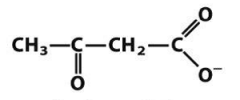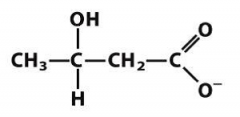![]()
![]()
![]()
Use LEFT and RIGHT arrow keys to navigate between flashcards;
Use UP and DOWN arrow keys to flip the card;
H to show hint;
A reads text to speech;
21 Cards in this Set
- Front
- Back
|
what are pre-cursor molecules of oxaloacetate? |
glucose glucogenic AAs odd-chain FAs (succinylCoA --> OAA) glycerol (--> DHAP --> pyruvate) lactate (--> pyruvate) |
|
|
in liver cells, what happens with OAA during extreme starvation |
there is no net gain of OAA
OAA is used to produce glucose (via gluconeogenesis)
OAA used in citric acid cycle --> provide energy for the liver |
|
|
what happens to acetylCoA during extreme starvation |
there is a build-up of acetylCoA molecules because no net gain of OAA
the acetylCoA molecules are used to construct ketone bodies |
|
|
what are 3 ketone bodies? |
1. acetone 2. acetoacetate 3. D-beta-hydroxybutyrate
"blood friendly" versions of acetyl CoA |
|

|
acetone |
|

|
acetoacetate |
|

|
D-beta-hydroxybutyrate |
|
|
acetone |
ketone body produced in smaller quantities and is exhaled |
|
|
acetoacetate |
ketone body transported by blood to tissues other than the liver (including skeletal and heart muscle, renal cortex, and the brain) |
|
|
D-beta-hydroxybutyrate |
ketone body transported by blood to tissues other than the liver (including skeletal and heart muscle, renal cortex, and the brain) |
|
|
why can't the brain use free FAs for energy? |
FAs are not able to penetrate the BBB -prolonged starvation -> 75% of fuel required by the brain comes from ketone bodies |
|
|
where are ketone bodies produced? |
liver cells mitochondrial matrix |
|
|
acetoacetate synthesis |
1. 2 acetylCoA molecules combine to form acetoacetylCoA (reverse of last step of B-ox) via thiolase 2. acetoacetylCoA condenses with another acetylCoa to form HMG-CoA via HMG-CoA synthase -a CoA is produced in this step! 3. HMG-CoA is cleaved to form acetoacetate via HMG-CoA lyase -acetylCoA is also produced |
|
|
acetone synthesis from acetoacetate |
decarboxylation via acetoacetate decarboxylase |
|
|
D-beta-hydroxybutyrate synthesis from acetoacetate |
via D-beta-hydroxybutyrate dehydrogenase using 1 NADH |
|
|
what determines whether acetoacetate or D-beta-hydroxybutyrate is made? |
the ratio of NADH/NAD+
higher [NADH], then higher [D-beta-hydroxybutyrate] |
|
|
what happens to D-beta-hydroxybutyrate when it arrives at extrahepatic tissues? |
it is oxidized (+1 NADH) to form acetoacetate via D-beta-hydroxybutyrate dehydrogenase |
|
|
what happens to acetoacetate when it reaches extrahepatic tissues |
after 2 enzymatic steps (beta-ketoacyl-CoA transferase and thiolase), acetoacetate is made into 2 acetylCoA molecules
the acetylCoA can enter the TCA cycle of extrahepatic tissues |
|
|
why do liver cells express extremely low levels of beta-ketoacyl-CoA transferase? |
liver cells are the producer ketone bodies
the liver does not want to utilize the KBs for energy production - would be a futile cycle |
|
|
where do extrahepatic tissues obtain OA during severe starvation? |
from glucose that is produced from the liver |
|
|
ketoacidosis |
an increased concentration of ketone bodies in the blood -due to accumulation of acetylCoA if prolonged starvation or untreated diabetes
ketone bodies are acidic and can cause significant lowering of blood pH this can lead to coma and death |

